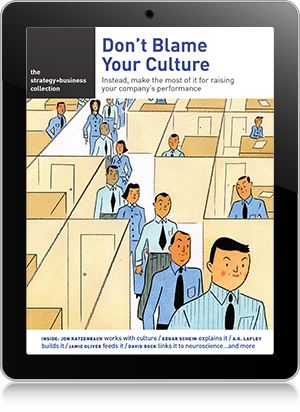The Cult of Three Cultures
The sum of operational, executive, and engineering cultures is greater than the corporate whole.
In 1990, when he became the CEO of the General Motors Corporation, Robert Stempel was known as a quintessential “car guy.” He took pride in having risen from junior engineer to head of General Motors’ giant Buick–Oldsmobile–Cadillac Group and then to CEO. He seemed to care deeply about the people who worked for him and the machines they made; he knew enough about cars and customers to face down the bean counters, and enough about people and technology not to be dazzled by hype.
The strategy+business Collection: Don’t Blame Your Culture
 This article is featured in the strategy+business app “Don’t Blame Your Culture,” available for smartphone and tablet devices. The app pulls together s+b’s best writing on organizational culture and change, featuring Jon Katzenbach, TV chef Jamie Oliver, former P&G CEO A.G. Lafley, and more, explaining why companies resist wholesale change, and how to make the most of the culture you have.
This article is featured in the strategy+business app “Don’t Blame Your Culture,” available for smartphone and tablet devices. The app pulls together s+b’s best writing on organizational culture and change, featuring Jon Katzenbach, TV chef Jamie Oliver, former P&G CEO A.G. Lafley, and more, explaining why companies resist wholesale change, and how to make the most of the culture you have.
To download, select your device:
But after only two years, GM’s board forced Mr. Stempel to resign. Judging from most accounts of those events (particularly Comeback, the incisive auto industry history by Wall Street Journal reporters Paul Ingrassia and Joseph P. White), Mr. Stempel lost his new job because he was culturally at sea — even though he had spent his career at GM, and had been an executive there for at least a decade. Instead of cutting unprofitable lines, consolidating boldly, and boosting cash flow, Mr. Stempel, as Messrs. Ingrassia and White put it, “was managing for the long term, moving step-by-step to close plants and develop new models.” Worst of all, he “didn’t see that his job was in immediate danger.” When the axe fell, despite a year’s worth of warnings from friends on the board, he was so surprised and hurt that he didn’t attend his own retirement dinner.
The problem was not lack of qualification. Mr. Stempel was apparently a very capable man who could have been an example of why production people, and not their financiers, should be at the helm of companies. Instead, he became yet another in a long line of discredited “car guys” and their equivalents. When Kodak’s new chief financial officer was asked why analysts should trust his company’s promises, he replied, “Because this is the post-Stempel world.”
In short, Mr. Stempel failed because he was culturally out of sync, not necessarily with GM as a whole, but with the innate demands of his new job. That, at least, is how MIT professor Edgar Schein, the “dean” of American experts in corporate culture, would explain it. Professor Schein suggests that there are at least three separate professions creating their own cultures within every large corporation. Professor Schein calls them the “operational,” “executive,” and “engineering” cultures. Each has its own attitudes about people, work, money, time, technology, and authority. The exact names and descriptions of these professional cultures, as we’ll see, are open for debate, but the heart of the theory is the inherent conflict among them. Members of each culture consistently misunderstand each other, even when they earnestly desire to work together.
If the idea of multiple corporate cultures seems peculiar, perhaps it’s because most people who study management can’t stop thinking about corporations as monoliths. We should know better; we see the infighting among corporate subgroups constantly. Yet we speak casually of there being one GM or DuPont or Shell. We say “P&G is cautious” or “Microsoft is ruthless” as if these companies were sentient creatures, each one with its own single brain (at the center of which is the CEO). We conveniently forget the fact that no real-world corporation works that way.
But when we become aware of the separate cultures, we can see precisely why many CEOs who come up from the shop floor fail as dramatically as Robert Stempel did, whereas others succeed (and lose many of their old friends in the bargain). And we can also see, as Professor Schein has begun to suggest, that most blanket attempts to “change the culture” of a whole company are wasted efforts. No matter what the change message is, large companies are so diverse that an influential minority will be predisposed to hate it.
The Parts vs. the Whole
Professor Schein helped found the field of organizational development (OD) in the 1950s (when he studied the reeducation of American prisoners of war coming back from Korea and corporate training centers at IBM and General Electric). Over the years, he has been a rigorous researcher, a key advocate for slow, thorough, and gentle corporate change initiatives (a column called “Culture & Change” would probably not exist if it weren’t for his subtle influence), and a mentor to such eminent organizational learning figures as Peter Senge.
Unlike most organizational learning and OD theories, which tend toward the monolithic view, Professor Schein’s three-cultures theory is not very holistic. It concentrates not on the essence of a corporation, but on its parts. These parts don’t fit together with machinelike precision, because a corporate culture is not a machine. Professor Schein’s three corporate cultures fit together in a vague, insubstantial way that actually makes them all the more influential. They affect us because they are unseen.
The first, the operational culture, is the culture of day-to-day line managers — the people who get products and services out, procure supplies, process bills, and make delivery trucks run on time. Operations people appreciate teams; they understand, as nobody else does, how to get a bunch of disparate individuals to pull together. Indeed, the operations culture is grounded in an ingrained awareness of the way that quality of life depends on the capability and reliability of good people.
Leaders in this culture are often connoisseurs of human “character.” They expect good people to be loyal, candid, and trustworthy, and they do their best to shut out those who do not fit in. They develop an easy skepticism about overarching solutions; they know that technology generally doesn’t work unless people are around to compensate for the flaws and bugs in the design. And although many operations managers appreciate the importance of raising capital, there’s no gut feel for finance built into the operations culture.
If you want to find facility with deals, leverage, and capital flow, you have to look to the second corporate culture, the executive culture. Members of this culture typically include the CEO, the board, the business-unit leaders, and the finance-oriented staff. Although they may support learning and human potential, their jobs and passions lie in shepherding the cash flow that keeps the organization alive. They are the only ones directly accountable for the organization’s obligation to return money and value to outsiders, both to shareholders and to society at large. As Professor Schein notes, they tend to see themselves as lone heroes, embattled and competitive. They are the last recourse in a crisis.
The executive culture, precisely because of its remoteness from ordinary human values, is not easy to move into. When the Boeing Company announced its headquarters’ move from Seattle to Chicago early this year, it was clearly a wrenching executive-culture effort to put some distance between the company’s decision-makers (who might have to relocate or close a plant) and their employees, friends, and neighbors. When CEOs like Robert Stempel don’t make it across the threshold from operations to executive culture, it’s often because they can’t write off their old loyalties to the people they left behind.
The third corporate culture, the engineering culture, is personified by engineers and technical specialists, particularly in information technology and process engineering. They are stimulated by puzzles and problems, and by the design challenge of creating an ideal world of elegant machines that operate in harmony. The only thing they’re impatient with is the other people. This culture, as Professor Schein puts it, is preoccupied with “designing humans out of the systems rather than into them.”
For instance, the engineers of the San Francisco Bay Area Rapid Transit trains designed a fully automated system, only grudgingly adding those downright unnecessary human conductors, just to reassure people and make them feel safe. The former Digital Equipment Corporation CEO Ken Olsen was a classic example of the engineering culture, passionate about machine design but unable to grasp the implications of a sales-to-employee ratio that was way out of line with everyone else in the industry.
People immersed in any one of these three corporate cultures have a hard time seeing that others have a different view of reality. Thus, operators who see people as potentially valuable team members, executives who see them as expendable resources, and engineers who see them as troublesome nuisances may bristle when confronted by someone from a different professional culture. They don’t understand why their cross-cultural counterparts are being so difficult.
Cult Status
It was just such a conflict that led Edgar Schein to recognize the three corporate cultures in the first place. A fellow MIT professor, John Carroll, had studied efforts to install more effective anti-disaster systems at nuclear power plants. The operations managers demanded training; they “knew” that only good team skills could keep the plant running. Engineers preferred to redesign the controls, “so we need fewer operators. After all, most error is human error.” And the executives of the power companies ignored the operators and blocked the engineers: “If we let the engineers design what they really want, they’ll bankrupt us,” they declared.
As Professor Schein listened to this story of frustration, the theory emerged. He gave a couple of talks on it, and published a brief article about it in the Sloan Management Review in 1996, but paid little attention to the theory after that. It cannot be found in Professor Schein’s books — not even in his recent guide to in-house culture diagnosis, The Corporate Culture Survival Guide (Jossey-Bass, 1999). Nor is it mentioned in Reflections, the MIT Press journal he edits.
Despite this, the three-cultures theory has taken on a kind of cult status among learning organization and organizational change professionals, if only because it lingers in the mind — and because most OD people don’t know quite what to make of it.
When I asked Professor Schein why he has not published anything more recent about the theory, he said he hasn’t had time. But I suspect that something else is going on. The three-cultures theory calls into question many of the practices that OD people take for granted, particularly in their most cherished work, up-close coaching with CEOs and other executive leaders. Edgar Schein has devoted his life to showing people how to “do no harm” in organizational consulting; he would naturally be reluctant to lob a bomb, even a small one, into the heart of his own profession.
For if this theory took hold, then OD people (and internal organizational consultants of all stripes) would finally stop advising finance-oriented executives to be more humanistic and compassionate. “All this humanism is potentially making them less effective at being a CEO,” Professor Schein said in a recent interview. A really good OD consultant at GM, for instance, might have tried to help Robert Stempel navigate that transition to CEO better, coaching him to become more sophisticated about high-level finance and more attuned to the signals he was sending large investors. Very few OD people could accomplish this, so they’d have to cede the role to a different kind of coach. Similarly, if this theory is correct, then they could no longer (in good conscience) put engineers through team-building or out-of-the-box creativity sessions; instead, they would try to help engineers be better engineers.
That doesn’t mean that corporations should simply settle for the status quo, letting executives, operations people, and engineers continue in their separate bailiwicks, complacent in their mutual misunderstandings. Companies turn to OD professionals in the first place precisely because there’s always a frustrating fragmentation problem to solve somewhere. (Businesspeople often call it the “stovepipe” or “silo” problem.) Although corporations like to talk about cross-functional cooperation, people don’t work well across professional cultures. They probably never have.
Culture and the CEO
About 10 years ago, a sociologist named Neil Fligstein, currently at the University of California at Berkeley, published a book called The Transformation of Corporate Control (Harvard University Press, 1990). It has some compelling resonances with Professor Schein’s theories. Professor Fligstein posited that the modern corporate world has changed its dominant culture several times during the past century. As political and economic realities changed, cultural trends in CEO thinking changed with them.
Thus, in the 19th century, the most successful CEOs were monopolists, dominating their industries by acquiring or wiping out competitors. Once antitrust laws made that stance unfeasible, corporations passed into what Professor Fligstein calls a “manufacturing conception of control” — his name for the operations culture. At the great vertically integrated companies of the 1920s, like DuPont, International Paper, and U.S. Steel, the CEOs were all operations men.
In the 1930s, when the Great Depression hit, control passed to marketing-oriented CEOs like Alfred Sloan of General Motors. Professor Fligstein also counts Henry Ford as more of a marketer than a production CEO. His greatest innovation, after all, was not the assembly line but the $200 automobile. This cultural shift reached its apotheosis in the golden age of advertising in the 1960s, when an au courant CEO seemed more aware of the television budget than the production schedule.
Then, in the late 1970s, when inflation drove the cost of capital sky-high and new avenues for raising capital emerged, corporate culture changed again. Finance-oriented CEOs took hold. Professor Fligstein’s book doesn’t quite cover this era, but in a recent interview he said the current preoccupation of CEOs with share prices simply didn’t exist before the 1980s. Keeping the share price high was a priority, to be sure, but not the imperative — the cultural imperative, you might say — that dominates executive thinking today.
“When stock prices were looping sideways while corporate assets were inflated in value,” Professor Fligstein said, “it looked on the balance sheets like most companies were in terrible shape. Around 1980, people like Michael Milken figured out that the firms were worth more broken up than whole. Only then did our current phase of shareholder-value rhetoric start to develop.”
It is significant, I think, that Professor Fligstein’s corporate cultures — monopolist, manufacturing, marketing, and finance — don’t quite map on to Edgar Schein’s corporate cultures of operations, engineering, and executive. For in a typical company, there are many significant professional cultures, including one of organizational development, Professor Schein’s profession.
Nor is every CEO a financial creature, even today. Perhaps “only the paranoid survive” in Silicon Valley, as Intel CEO Andrew Grove’s autobiography put it, because there are so many engineering-culture executives around, and their culture fundamentally mistrusts people.
Edgar Schein and Neil Fligstein have never met or spoken, but when you put their ideas together, you get a picture of corporate cultures as not just a factor in corporate change, but perhaps as the most significant force in determining the company’s future. As Robert Stempel discovered, a CEO can’t choose a culture to adopt; the culture chooses the CEO.
But that doesn’t mean the current finance culture will dominate forever. There was a time when it seemed that operations guys would run the company — and, in fact, the world. And there may yet come a time when some new cultural imperative beyond shepherding capital becomes dominant. It’s hard to imagine CEOs getting appointed for their ability as teachers or poets — but stranger things have happened. ![]()
Reprint No. 01302




